Whenever I step into my backyard, I crave a sense of peace and privacy, where I can truly relax and feel at home. There’s just something magical about transforming an outdoor space into a cozy hideaway, shielded from outside noise and curious eyes. I’ve found that fast growing privacy shrubs are a beautiful way to create a lush, green barrier that completely changes how your yard feels. It’s about turning any garden or patio into your own little retreat, filled with natural life and soothing greenery.
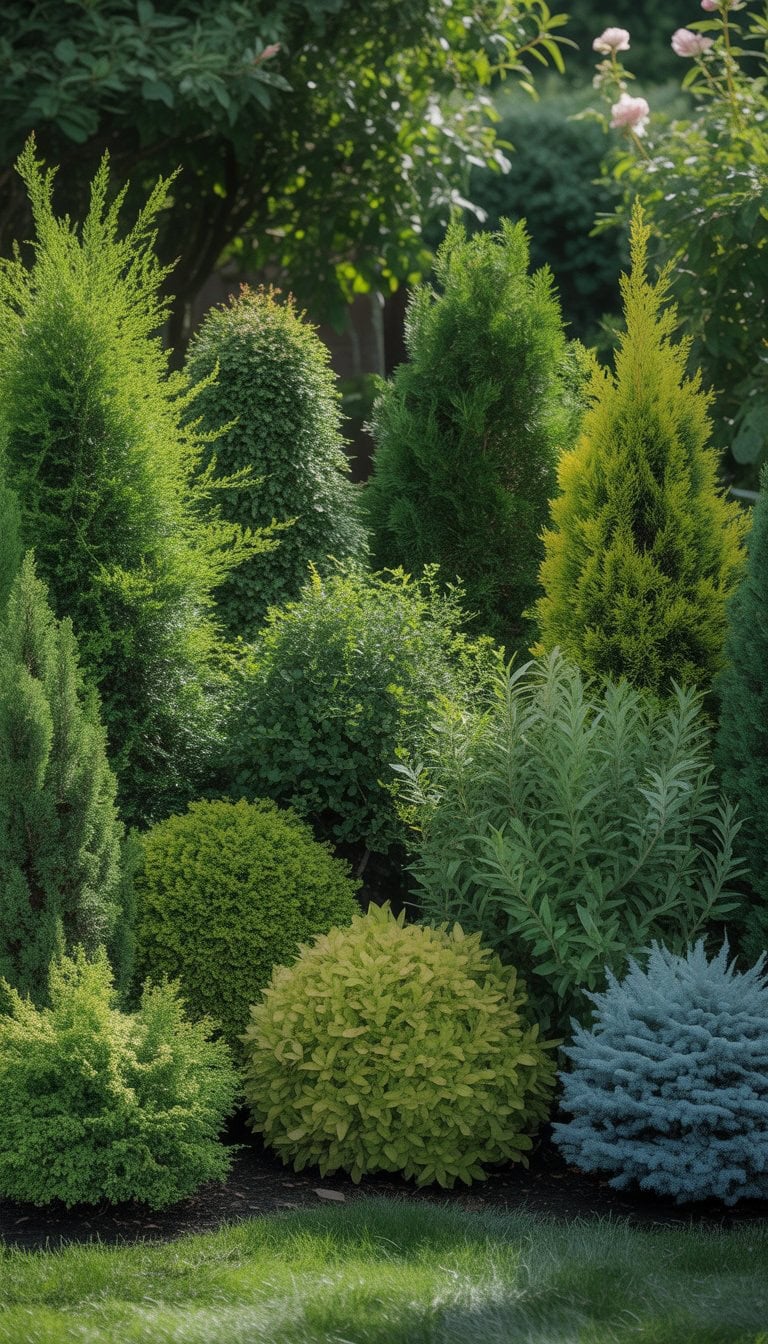
Every time friends visit, they always ask how I turned my simple yard into a secluded oasis. For me, it’s all about picking the right shrubs that grow quickly and fill in the space, making the area feel both private and inviting. With a mix of color, texture, and height, I love how these natural “walls” add charm, comfort, and even a bit of wonder to any outdoor space. I’m excited to share ideas and tips that can help anyone create the backyard escape they’ve always wanted.
Green Giant Arborvitae

I love planting Green Giant Arborvitae for privacy in my backyard. These evergreens grow tall and full, making a quick, natural screen without too much waiting.
In my experience, they can reach up to 60 feet when given the right care. I’m always impressed by their steady growth—up to three feet per year when they’re happy. It’s satisfying to see the space fill in every season.
Green Giants don’t need much from me except regular water. They’re okay with different soils and light, which makes gardening with them way less stressful.
For anyone who wants privacy without constant upkeep, I always recommend these Green Giants. These trees make my yard feel cozy and safe, letting me relax and enjoy the space. They’ve become one of my favorite choices for a lush, green retreat.
To learn more, check out this comprehensive guide on growing Green Giant Arborvitae.
North Privet
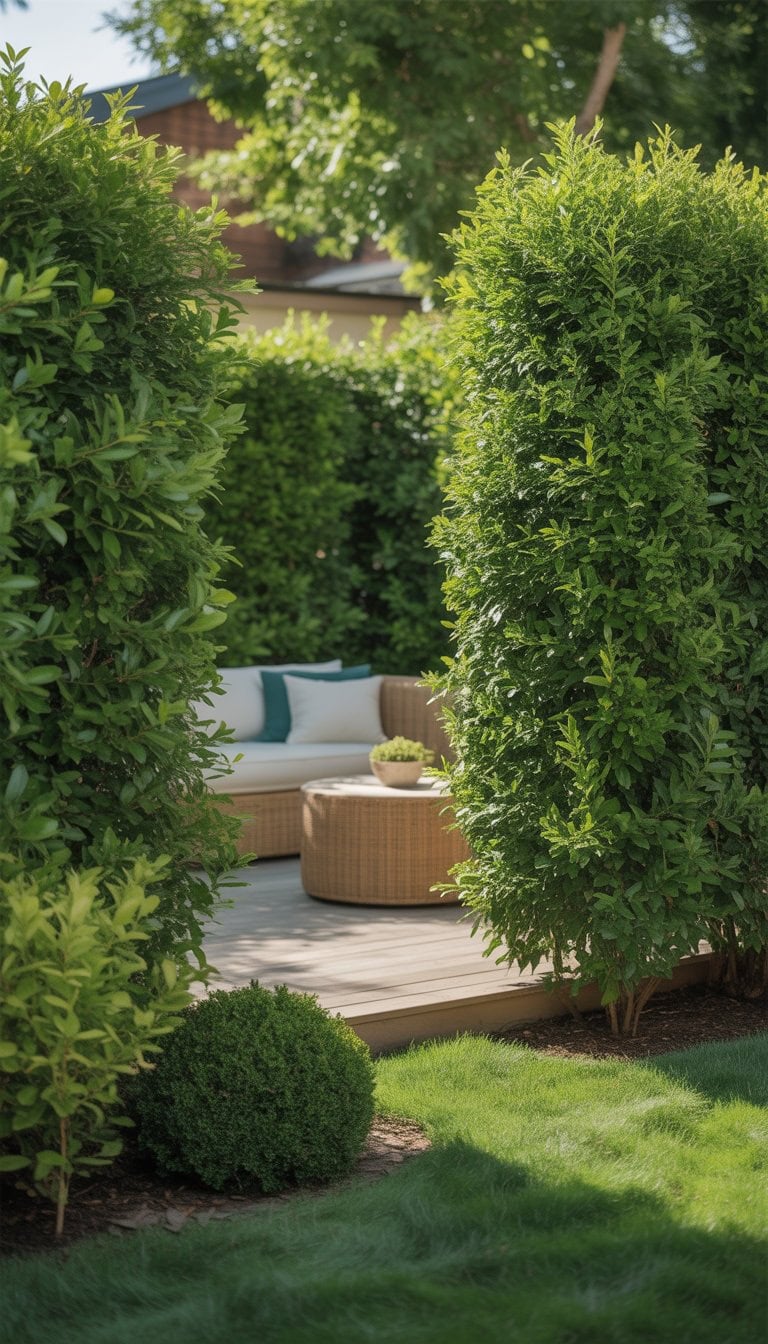
I love planting North Privet when I want quick results. This shrub grows fast, often around three feet per year, which means I don’t have to wait long for more backyard privacy.
The dense green leaves fill in my yard walls, giving me a nice shield from neighbors. When trimmed, North Privet forms tidy, smooth hedges. I find it easy to shape, which helps if I want a formal look.
I also like that North Privet can reach about 8 to 12 feet tall. This is just the right height for blocking views without feeling closed in. If you want a hedge that works for most yards and grows quickly, North Privet is a solid pick. You can learn more about it and other ideas from the Budget Dumpster guide on privacy shrubs.
Oakleaf Hydrangea
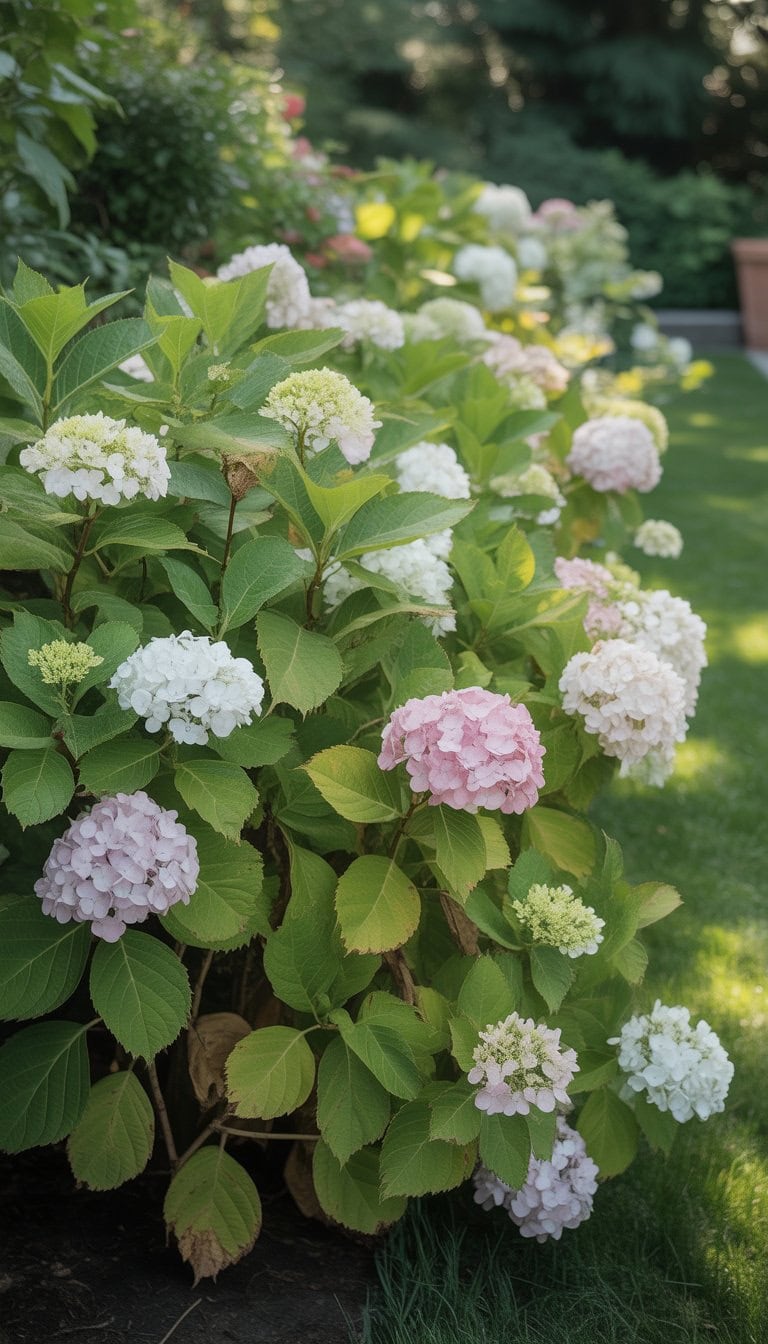
I love adding oakleaf hydrangea to my garden for both beauty and privacy. The big leaves and tall growth make a natural screen, which helps my yard feel peaceful and hidden.
These shrubs grow between 3 and 12 feet tall, filling in spaces quickly. Their showy blooms last a long time and look great cut or dried. The leaves even turn pretty colors in fall, so there’s always something interesting to see.
When I plant oakleaf hydrangea, I try to give them some morning sun and afternoon shade. This helps the plants grow well and keeps the leaves from getting burnt in hot weather. Moist, well-drained soil is key—just a little care makes a big difference.
Using 5 to 7 of these together has worked for me as a simple way to build a privacy screen. It’s a cozy, effortless option I keep coming back to for my own backyard retreat. For more tips, you can check out these oakleaf hydrangea landscaping ideas.
Carolina Rose
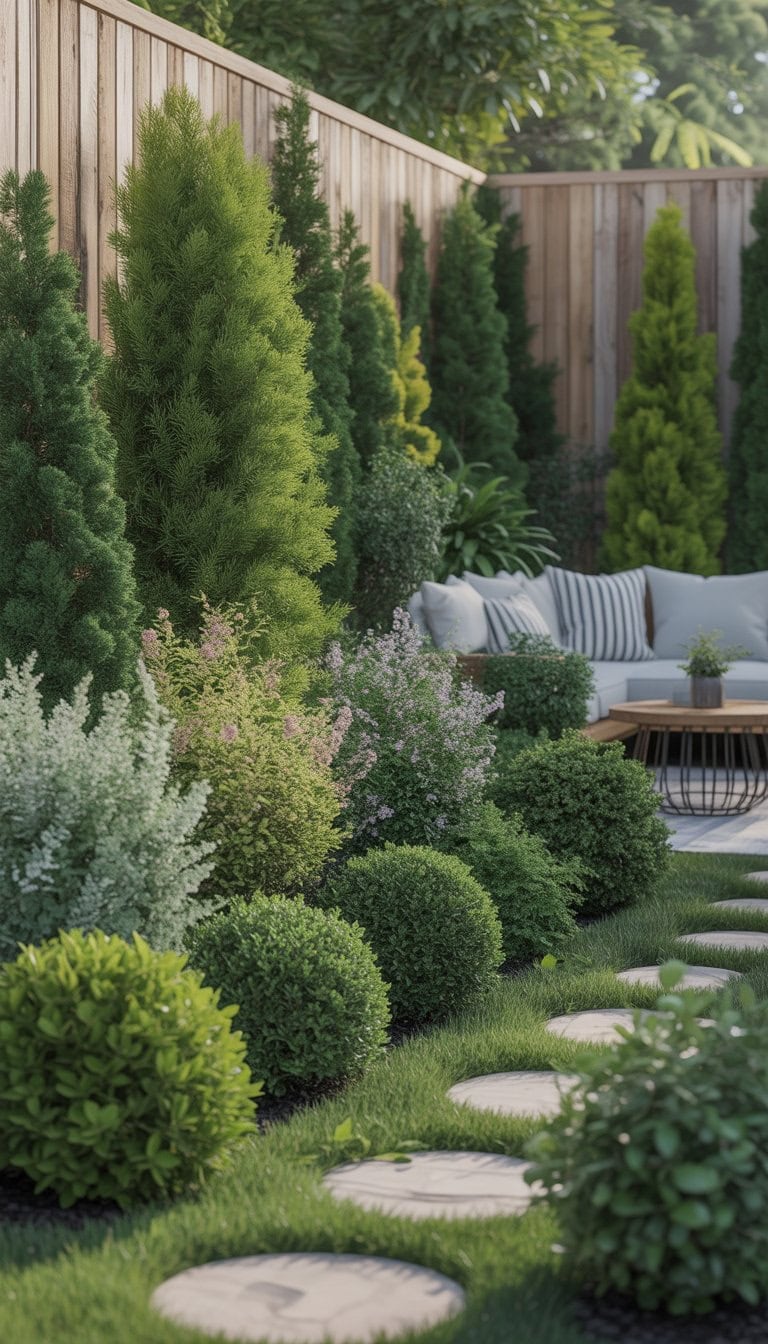
When I want both beauty and privacy in my yard, I always think of the Carolina rose. It’s a native shrub that brings a splash of color and covers up open spaces.
From late spring through summer, I get to enjoy its showy, fragrant pink flowers. The blooms attract pollinators, which helps my garden thrive even more.
Carolina rose isn’t just good looking. Its dense growth also forms a living barrier for privacy in my outdoor space. I like that it grows naturally along fences, patios, or the edge of my property.
It’s worth noting that Carolina rose is hardy and does well in many soil types. If you want a fast-growing privacy plant, this could be a strong choice for your own cozy oasis. You can learn more about Carolina rose as a privacy shrub.
Viburnum
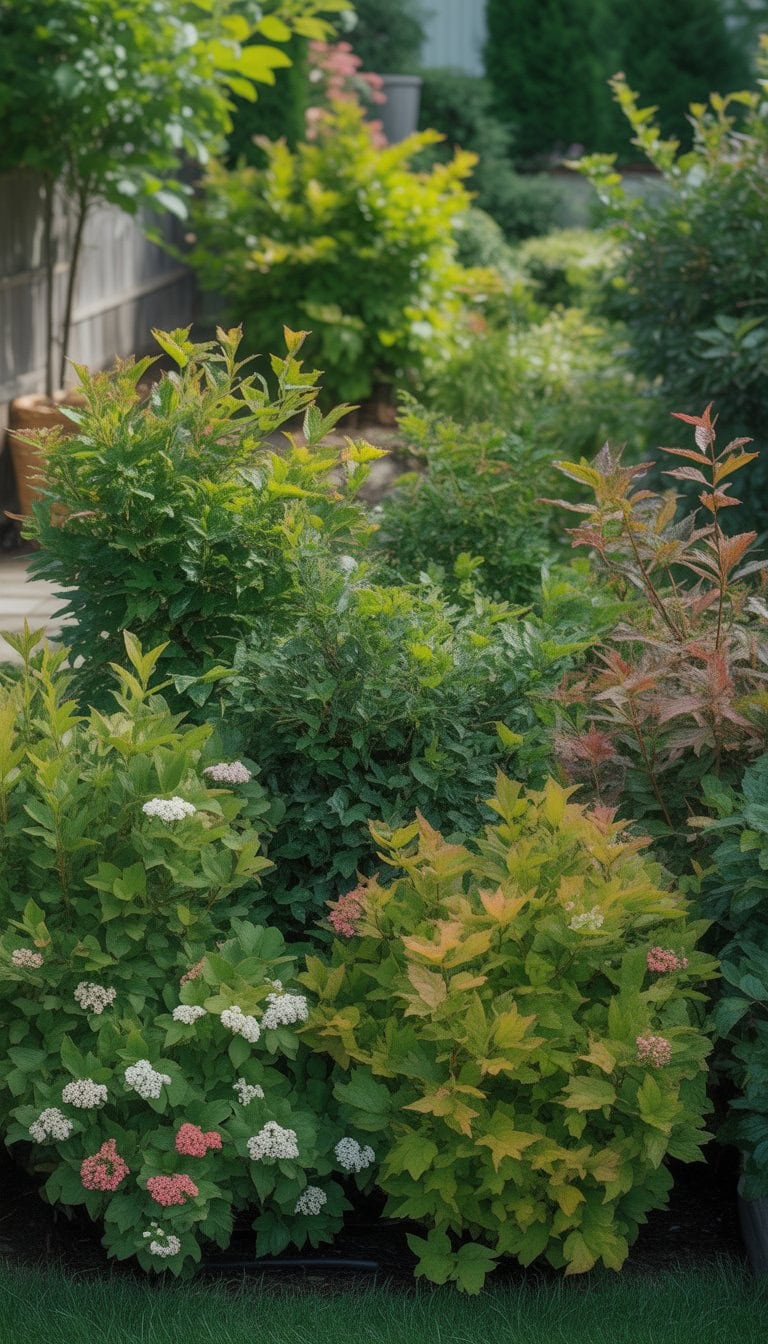
When I think about planting privacy shrubs, I often choose viburnum first. It feels like a classic for any yard where I want quick results. The way these shrubs fill in spaces gives me the seclusion I want without waiting for years.
I like that viburnum can grow fast. Some types add several feet of growth each year, making them perfect for creating a green wall in less time than most other bushes. Their dense branches also help keep my outdoor space quiet and private.
Every spring, I’m excited to see the clusters of fragrant flowers. The blooms attract butterflies and add a pop of color. Viburnum also comes in many varieties, so I always find one that fits my style. For more creative ideas, I like to see how others use viburnum in their gardens by checking out guides like this on landscape uses for viburnum.
Plum Pine
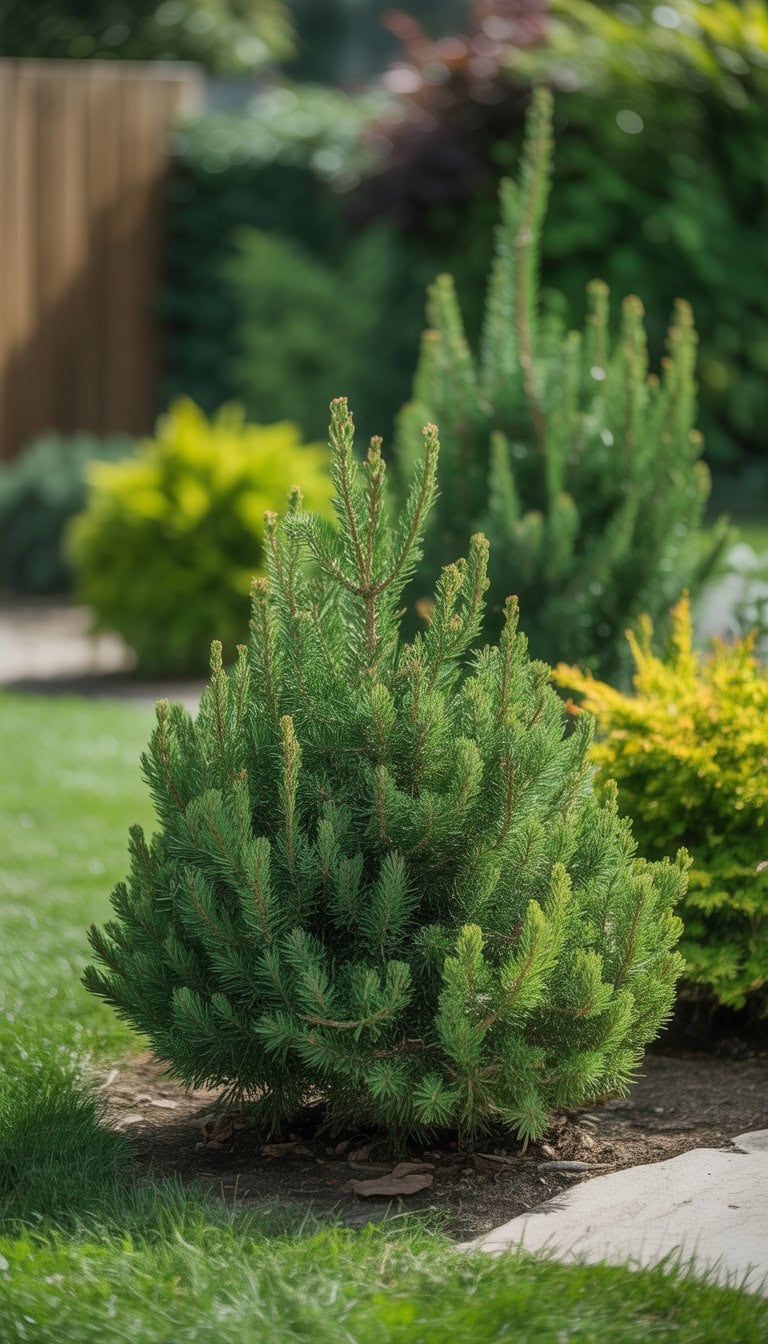
I love using Plum Pine, also known as Podocarpus, for privacy in my yard. It is an evergreen shrub, so it stays green all year. The dense, dark foliage makes a living wall that feels welcoming and secure.
Plum Pine grows upright and can be pruned to fit tight spaces or shaped into a hedge. I find it adapts well to sun or partial shade. It’s not fussy about soil and handles drought once established.
In my experience, Plum Pine adds a graceful touch because its leaves look soft and clean. I appreciate how easy it is to keep this shrub neat with simple trimming.
For year-round coverage, I think Plum Pine is a dependable choice. It’s also a good pick if I want a low-maintenance but lush privacy screen.
Holly
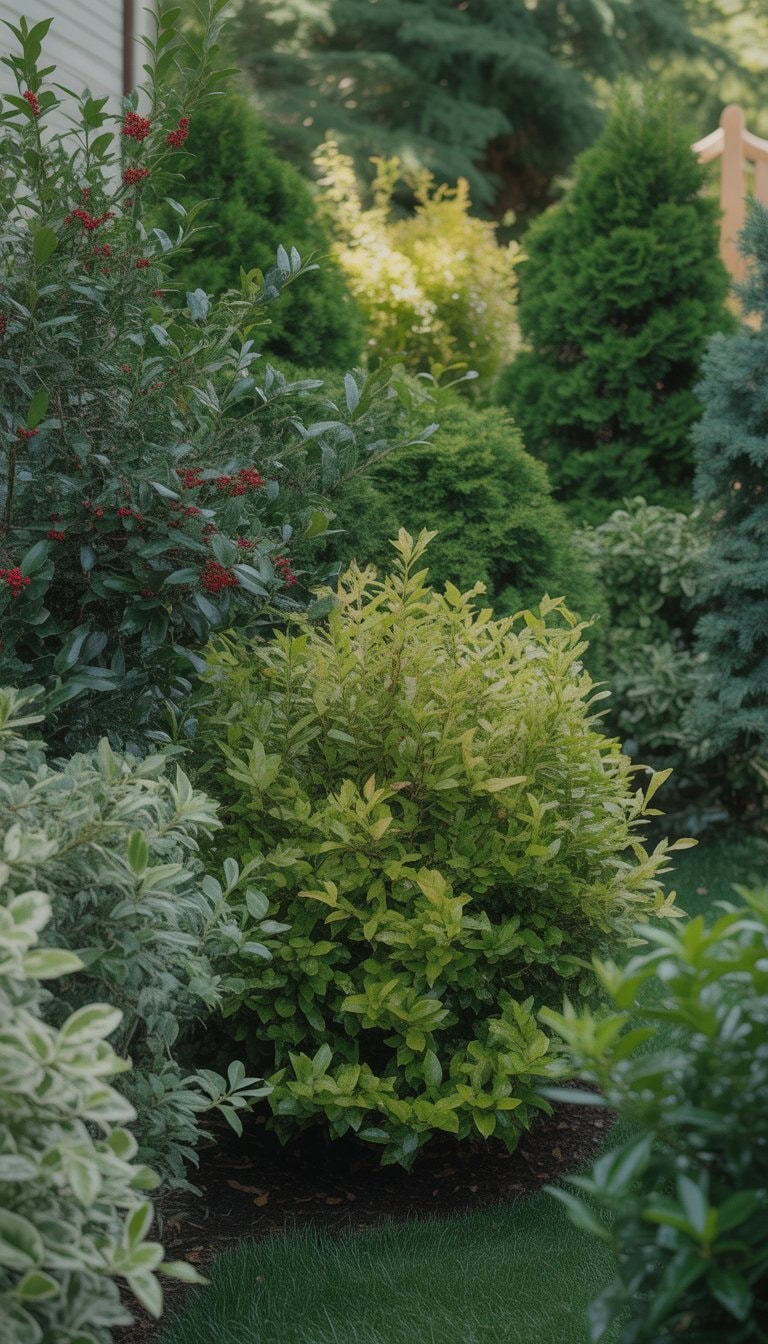
I love using holly in my yard because it gives me privacy year-round. The leaves stay green even through winter, and the dense branches make it hard for anyone to see through.
Many types of holly grow pretty fast and can get between 15 and 25 feet tall. That height gives me the perfect screen from neighbors or the street. The glossy leaves also look great and add color all year long.
I also enjoy the red berries that show up in winter. They bring a pop of color and often attract birds to my garden. Holly is tough and can handle different soil types, which makes it easy for me to grow.
I’ve found that holly works well as a hedge or as single plants for privacy. If you want something reliable and classic, holly is a smart pick for privacy screens.
Forsythia
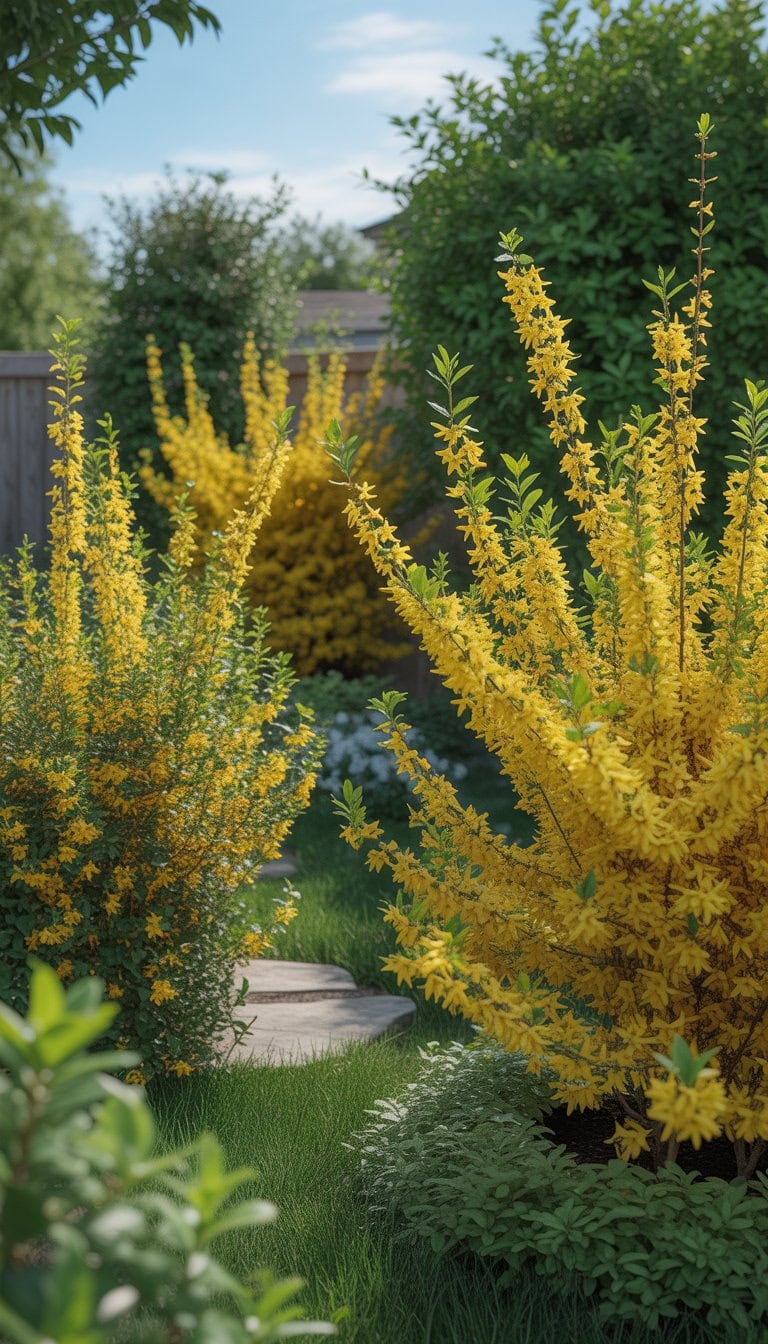
I always get excited when spring starts and my forsythia blooms. The bright yellow flowers are some of the first I see in my yard each year. It makes my space feel happy and welcoming after a long winter.
Forsythia grows quickly, which is great when I need privacy fast. I’ve noticed it can reach up to 10 feet tall in good conditions. If I want a living fence, this shrub is one of my favorites to plant.
I also like how easy forsythia is to care for. With just a bit of sunlight and water, it seems to thrive. If you want a colorful privacy screen, forsythia is a strong choice for any garden.
Thuja
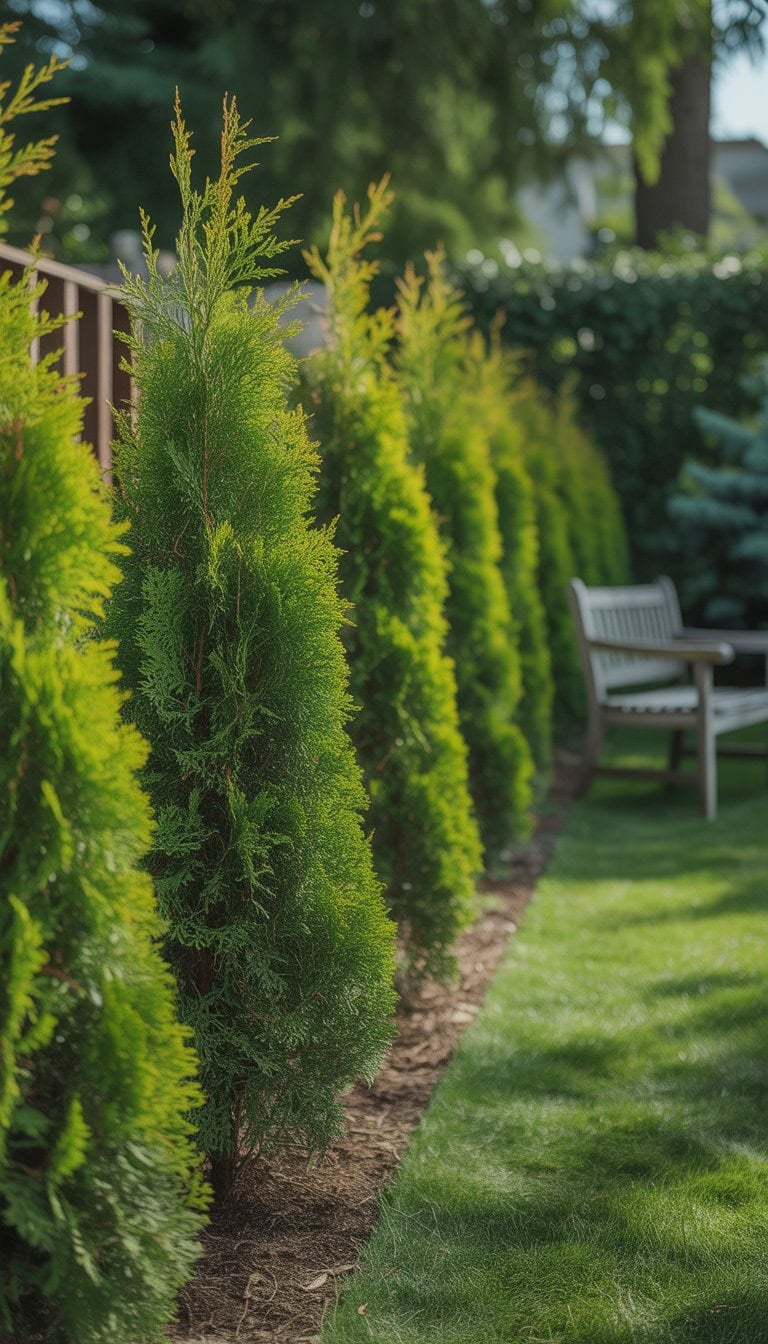
When I think about easy ways to add privacy to my yard, Thuja always comes to mind. These evergreens can grow tall and full, making them popular for natural screens.
I like how Thuja trees, especially the Green Giant variety, grow quickly once they settle in. They create a thick hedge that blocks views year-round.
I’ve seen how planting them close together forms a strong green wall. My neighbors used them along their fence, and the difference was noticeable in just a few seasons.
Thuja stays green no matter the season, so my yard always looks lively. I also enjoy how low-maintenance they are. If you want privacy that is both fast and reliable, these trees are a great pick. Learn more about using Thuja for privacy at this privacy hedge guide.
Boxwood
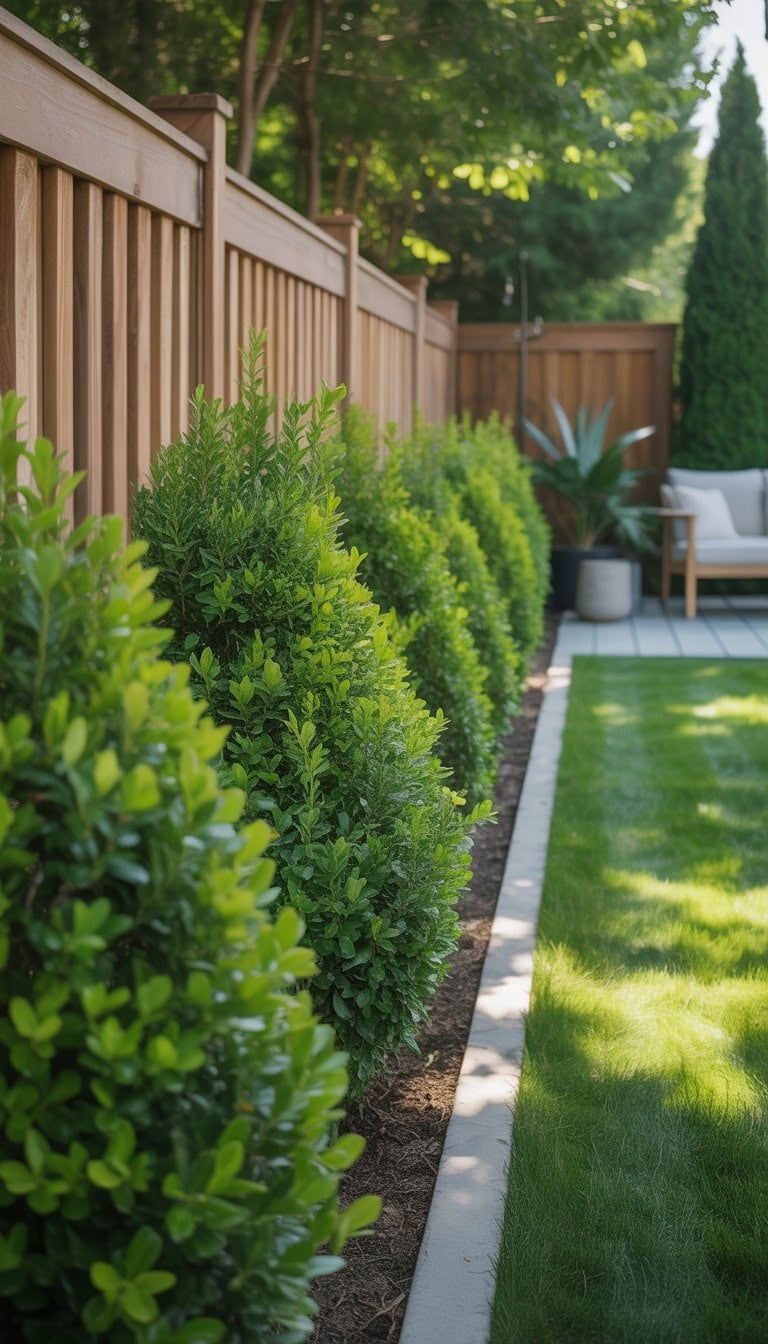
I love using boxwood as a privacy shrub. It keeps its rich green color through every season, which helps my yard look nice all year. The tidy, dense leaves are easy to trim into neat shapes or hedges.
When I want clean, classic lines, boxwood is my go-to choice. It grows slow to medium, but I find the wait is worth it. Once established, my boxwood plants need only basic care and occasional pruning.
I often use boxwood along fences or walkways for extra privacy. It fits with many garden styles, whether I want a formal look or something more relaxed. Adding these shrubs makes my space feel peaceful and inviting for family and friends.
If you want other ideas for privacy shrubs, boxwood is just one great option.
Dwarf Lilac
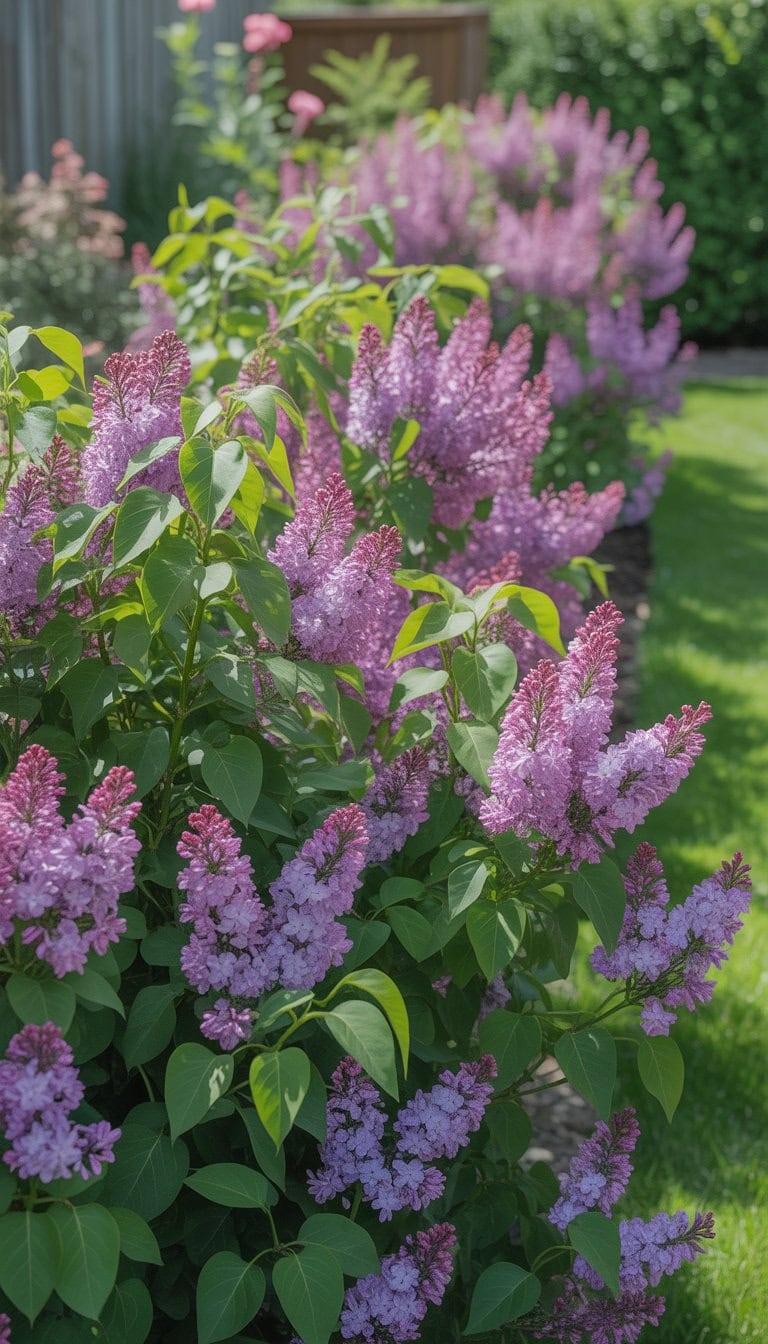
I love using dwarf lilac shrubs for privacy because they bring color and a sweet scent to any space. These small, rounded bushes fit perfectly into tight spots along my fence or around a patio.
When spring comes, I look forward to the bursts of lavender-pink blooms. Not only do they look great, but their fragrance makes my backyard feel welcoming and calm.
Dwarf lilacs are easy to care for. I don’t have to worry about constant pruning, and they don’t grow out of control. Their compact size also means I can use them as low hedges or in small gardens without them taking over.
If you want a privacy shrub that’s simple to manage and adds a touch of beauty, you might want to try a dwarf lilac in your garden.
Bamboo

I love using bamboo when I want to create instant privacy. Bamboo grows quickly and can make a lush, green wall in just a few seasons.
One of the best things about bamboo is its tall, upright canes. They block views without taking up much space, which is perfect for narrow yards like mine.
I recommend picking clumping varieties. These types are easier to control and won’t spread all over the yard. For me, they’ve been a great, low-maintenance choice for a natural barrier.
If you need fast results, bamboo is a solid option. You’ll notice a difference in privacy within a year or two. It gives my backyard that peaceful, secluded feeling that I really enjoy. If you want to see more ideas, check out these fast-growing privacy shrubs.
Ornamental Grasses
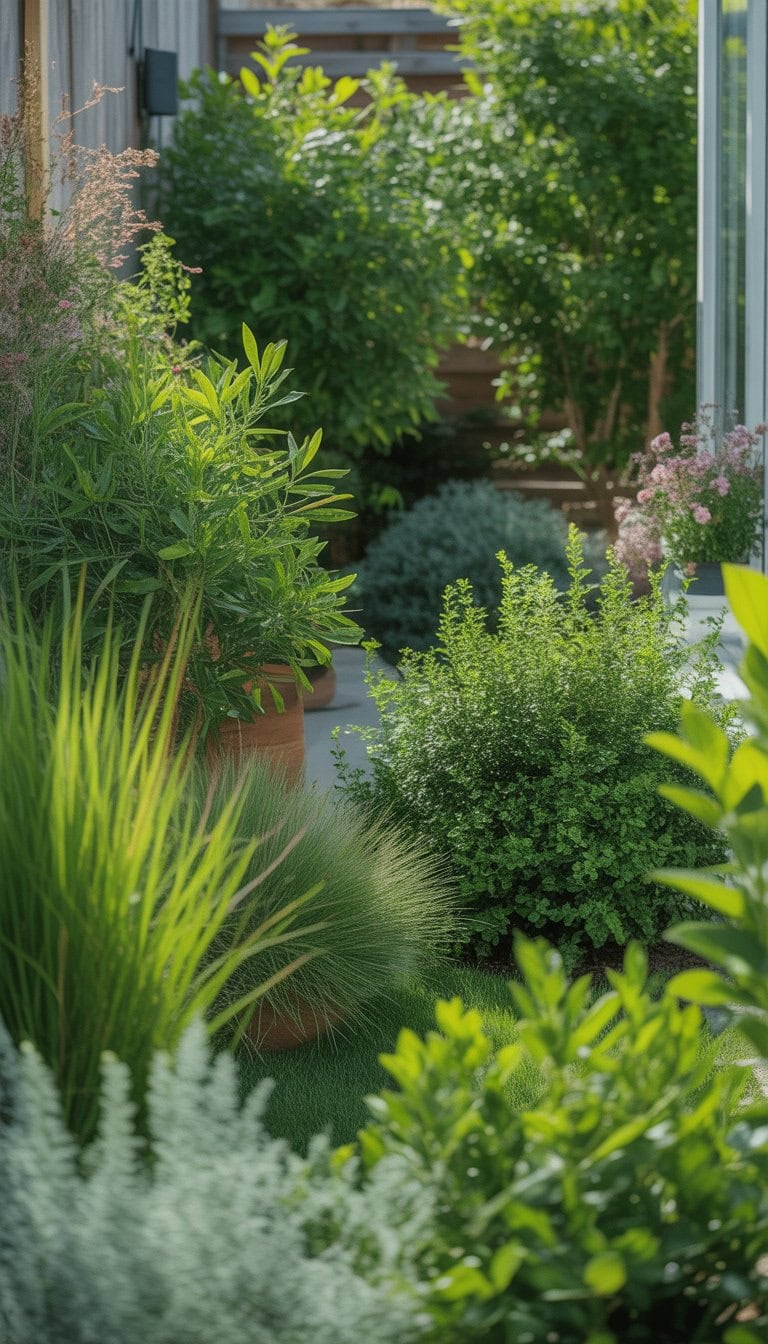
When I want my yard to feel private but still look fresh and modern, I love using ornamental grasses. These plants grow quickly, and their tall blades make a soft screen.
Some varieties, like maiden grass and switchgrass, can reach several feet high. They move gently with the wind and are easy to care for. Even in small spaces, ornamental grasses can fit right in.
I’ve found that pairing a few types together makes the border look natural. Plus, they stay green for a long time, keeping my oasis hidden almost all year. There’s a nice list of ornamental grasses for privacy that offer lots of options.
I enjoy how these grasses add height and texture to my garden beds. They’re a simple way to get both beauty and privacy fast.
Redbud Tree
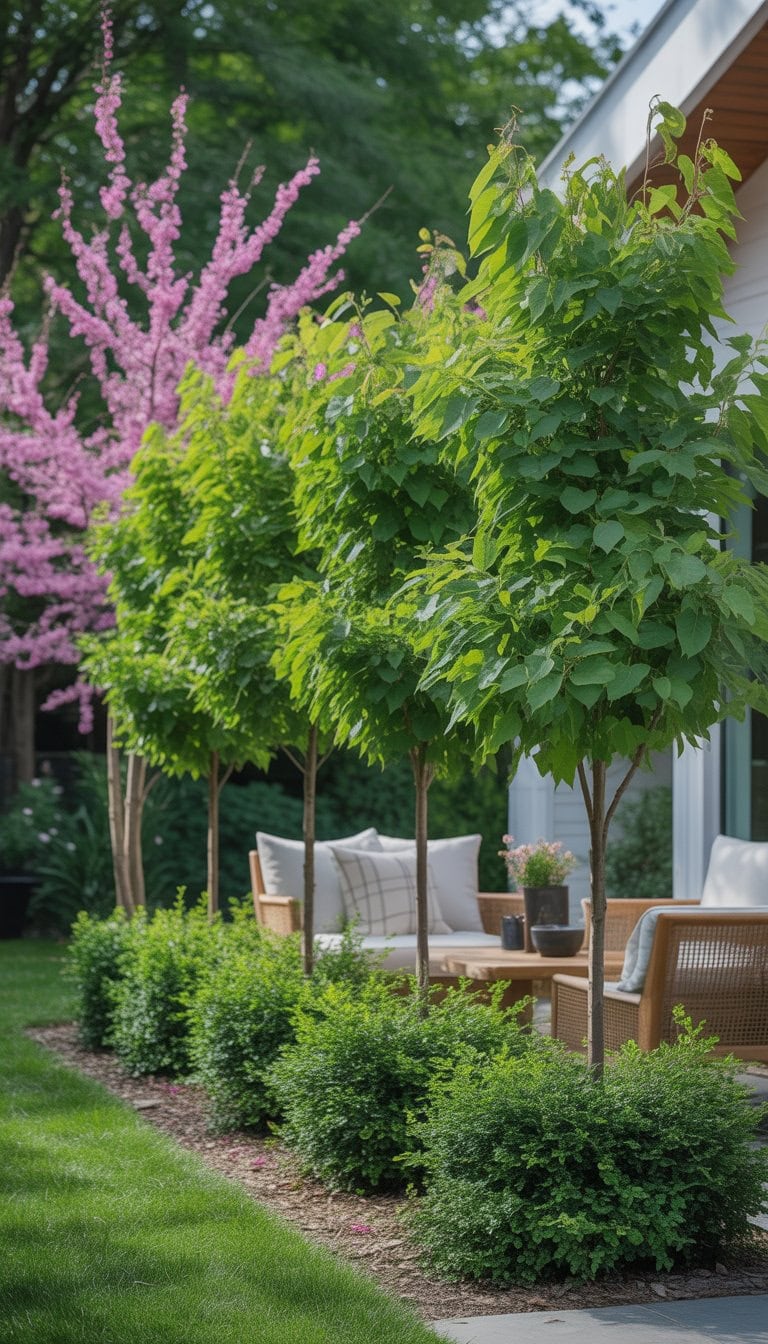
I love using the redbud tree when I want some quick color and privacy in my yard. Redbuds bloom with pink or purple flowers in early spring, bringing life to any garden spot. These trees are just the right size—they don’t get too big, so they fit nicely wherever I need extra cover.
When I plant redbuds, I make sure they get full sun for the best blooms, but they can handle a bit of shade too. I try to space them about 10 to 15 feet apart, giving each tree plenty of room to grow and spread their branches.
If I’m looking for a smaller option, the Don Egolf variety only grows about nine feet tall, while the Lavender Twist stays even shorter. Both work well if I want privacy without blocking out all the sunlight. Check out more redbud tree landscaping ideas.
Japanese Maple
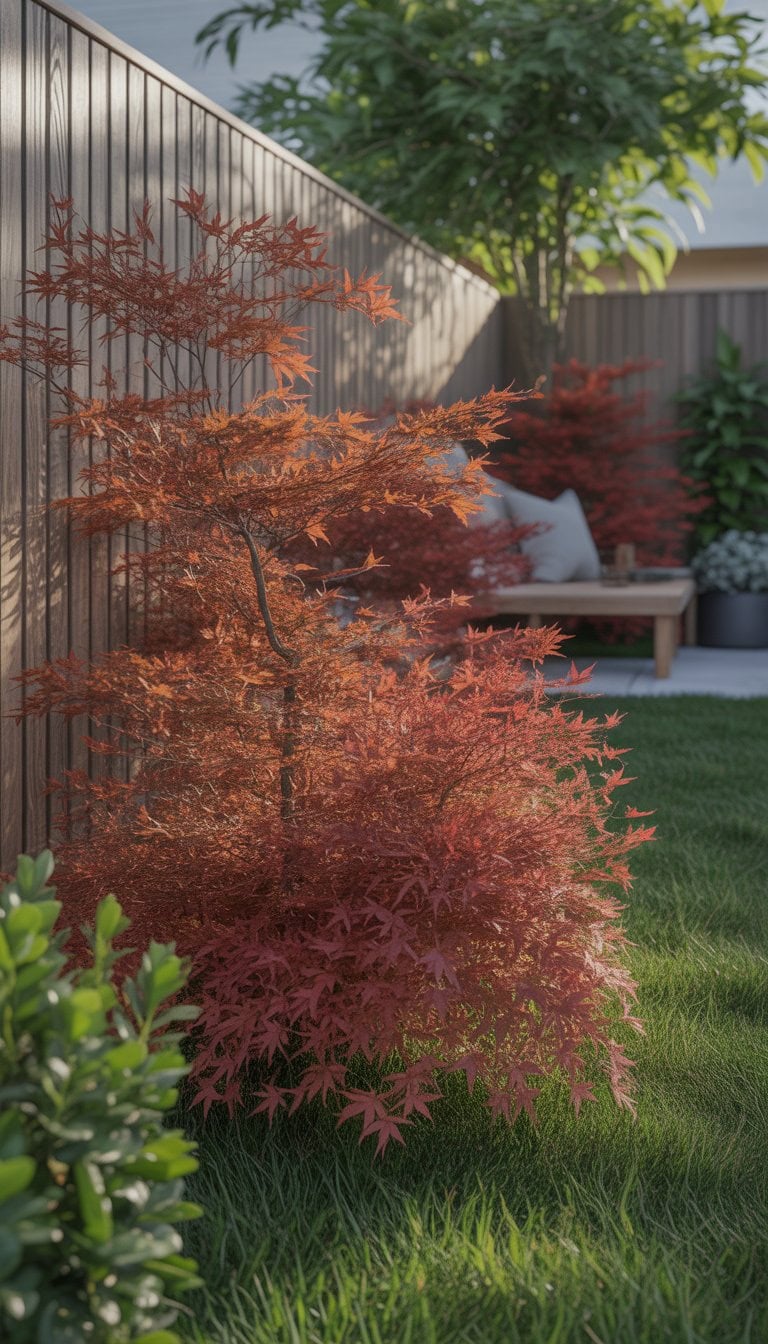
I love using Japanese maple trees in my yard. Their unique leaves and bright colors always catch my eye. Whenever I want to make a space feel calm and special, this tree does the trick.
Japanese maples grow slower than some shrubs, but they give my garden real character. I find their shape and size perfect if I want privacy without blocking all the sunlight.
Sometimes I mix them with boxwood or evergreens for a layered look. This helps create different textures and colors throughout the year. The red and orange leaves look especially nice in the fall.
If you want privacy with extra beauty, I recommend Japanese maple. They work well as a stand-alone tree or in a group with other shrubs. You can find more info about using Japanese maples in landscapes at Garden Goods Direct.
Designing Your Private Green Retreat
When I plan a private green space, I focus on how the layout and plant choices work together. The right combination stops nosy neighbors from peeking in and makes the yard more beautiful and peaceful for me.
Choosing the Right Location for Privacy Shrubs
I always start by walking around the yard and standing in the places where I want more privacy. I pay attention to where neighbors’ windows face or where people tend to walk by. This helps me figure out the spots where privacy shrubs will make the most difference.
Sunlight is important. Most privacy shrubs like hydrangeas, hollies, and viburnums need at least part sun to do their best. I usually check how the sunlight moves during the day. If there is a fence or a patio, I use it as a guide to line up the shrubs. This makes the barrier look neat and helps each plant get what it needs.
Drainage matters too. I make sure water does not pool where the shrubs will go. To test, I dig a small hole and see if water drains in an hour or two. Good soil drainage stops roots from rotting, which keeps the privacy wall healthy.
Combining Textures, Colors, and Heights
I don’t just want a green wall—I want a privacy screen that feels alive and interesting. I like to mix evergreen shrubs with flowering and deciduous ones for year-round appeal. For example, I might plant glossy-leaved hollies next to feathery forsythias and soft hydrangeas. These different leaves and shapes make the yard feel lush and cozy.
I plan rows by height. Taller shrubs like plum pine or certain viburnums go in back if my view is wide, with shorter varieties in front. This makes the hedge look good from both sides and lets light reach every plant.
When I use shrubs that flower at different times, I get blooms all season. For easy planning, I make a table to match shrub names to their color and blooming months. This helps me pick plants that work together and keep the retreat bright and inviting. For ideas about shrub types, I check suggestions like those found on Martha Stewart’s privacy shrubs guide.
Care Tips for Thriving Privacy Shrubs
Taking care of privacy shrubs is straightforward when I focus on the basics like water, food, and trimming. These main steps keep shrubs healthy, green, and thick so they offer better coverage and last for years.
Watering and Feeding Strategies
I make sure my privacy shrubs get enough water, especially during their first year in the ground. Most types need about 1 inch of water per week, either from rain or a garden hose. For quick-growing varieties, I check the soil by sticking my finger in; if it feels dry two inches down, it’s time to water.
I’m careful not to drown the roots. I use mulch, like shredded bark or pine needles, to keep the soil cool and less likely to dry out. Every spring, I put down a balanced slow-release fertilizer. Here’s what I usually look for:
| Fertilizer Type | Best Time to Apply | Why I Use It |
|---|---|---|
| All-purpose granular | Early spring | Easy and lasts longer |
| Liquid feed | Mid-summer | Quick boost for growth |
This routine helps new plants get strong and older shrubs stay full and green.
Pruning for Full, Lush Growth
I prune my shrubs at least twice a year, once in early spring and again after the main burst of new growth. This helps the shrubs stay thick instead of thin and scraggly. I always cut back dead, broken, or crossing branches first.
For hedges like boxwoods or hollies, I shape them into simple forms. I keep the bottom a bit wider than the top, which means sunlight reaches all parts. I use sharp shears or powered trimmers for straight lines and clean cuts.
If I see gaps, I cut a little deeper to encourage new leafy branches to fill in. I avoid cutting into old, brown wood, though, because many shrubs won’t sprout new growth from there. Regular pruning keeps privacy shrubs dense, healthy, and looking great all season.
Frequently Asked Questions
I get a lot of common questions about fast-growing privacy shrubs, especially when folks want a cozy space fast. Some plants work well even in tricky spots, and there are great options for dense coverage all year long.
What are some low-maintenance shrubs that grow quickly to ensure privacy?
In my experience, the Green Giant Arborvitae is hard to beat for easy care and quick growth. North Privet is another winner because it fills in fast and doesn’t need much help from me once it’s in the ground.
Both shrubs handle light trimming and survive most weather, so I don’t have to fuss over them.
Which shrubs thrive in shaded areas while providing a rapid privacy screen?
If your yard is shady like mine, don’t worry—Viburnum does well with less sunlight and still grows quickly. Oakleaf Hydrangea is another good choice. It shows off pretty blooms and still gets tall enough to give me and my family some privacy.
I look for these when my fences need extra cover where trees block the sun.
What options do I have for immediate backyard privacy with fast-growing plants?
For the fastest results, I’ve found that planting mature Green Giant Arborvitae gives almost instant cover. Planting them close together creates a thick wall even in the first year.
Cherry Laurel and North Privet also fill out spaces quickly if I need a barrier right away. For more ideas, I checked out this list of fast-growing privacy shrubs as well.
Can you recommend evergreen shrubs that grow quickly in shaded conditions?
I like Yew and certain types of Holly when I need evergreens for shaded spots. Both keep their leaves all year.
They grow steadily and give my garden privacy even in the winter. Holly also offers pretty red berries, which cheer up the shady corners.
What are the best bushes to plant for creating a natural barrier from neighbors?
I prefer using a mix of shrubs for the best privacy. Green Giant Arborvitae, North Privet, and Viburnum make a sturdy, green wall.
If I want something flowering, Oakleaf Hydrangea and Carolina Rose also work well and look great through different seasons. Planting more than one type gives a natural, layered look, just like in this helpful guide.
How can I select shrubs suitable for both shade and poor soil that will give me a lush privacy hedge?
I always go for tough shrubs like Viburnum and Oakleaf Hydrangea when the soil is rough and there’s not much sun. These shrubs aren’t picky—they grow in lots of conditions and still give me thick, leafy screens.
I check plant tags or ask at the garden center for varieties known to be hardy and shade-tolerant. That way, I know I’ll end up with a healthy, lasting hedge.
